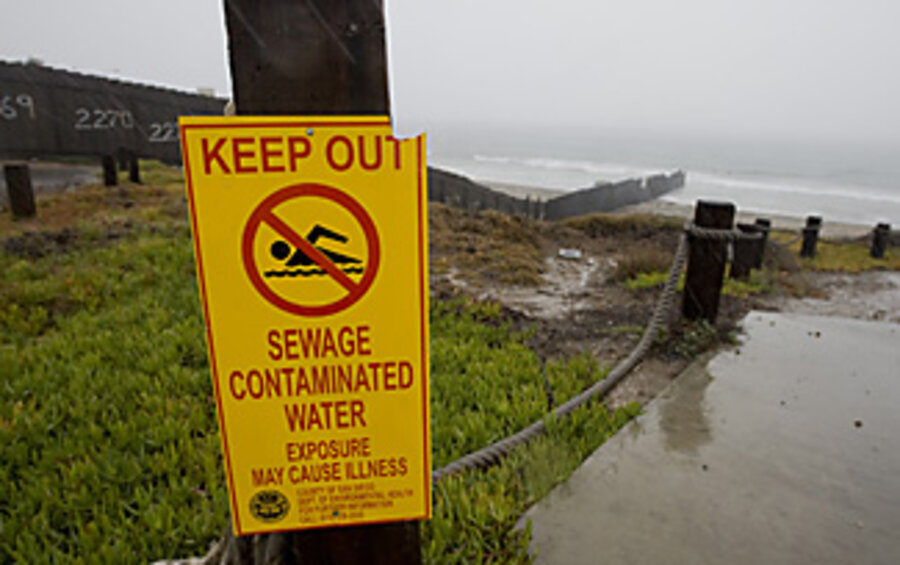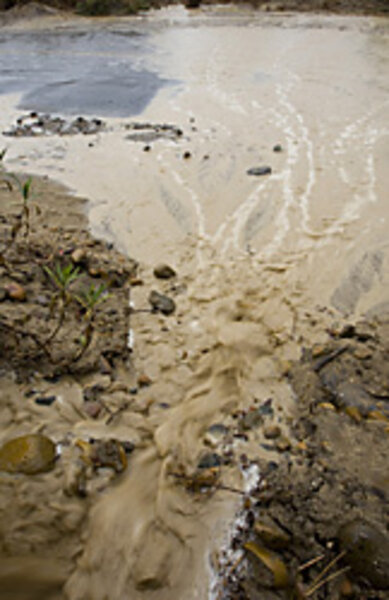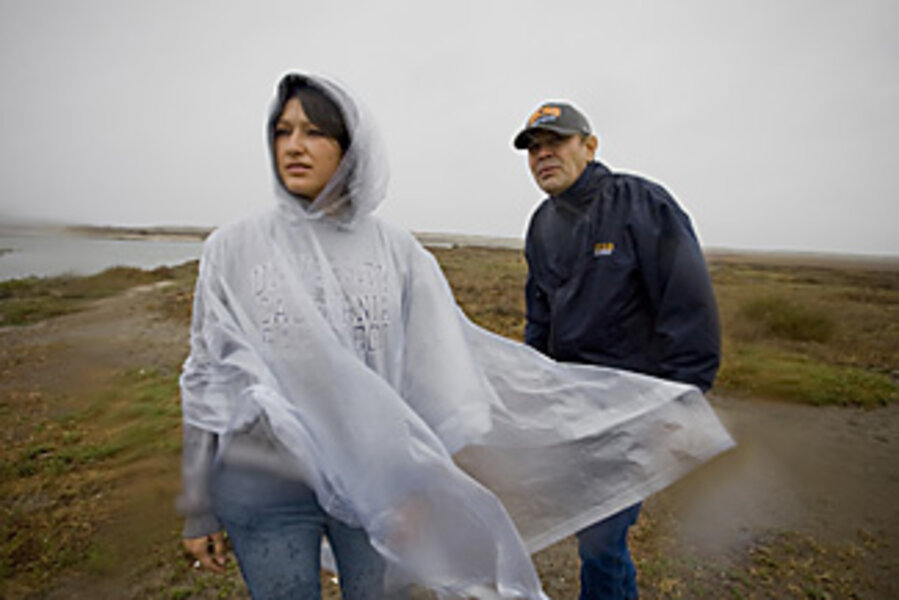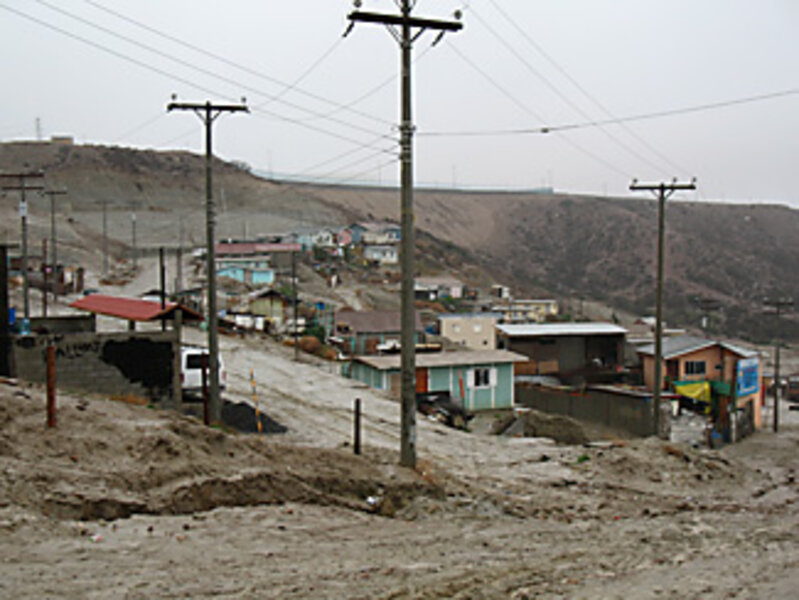San Diego aims to fix a pollution problem by helping a Tijuana slum
Loading...
| Tijuana, Mexico
When it rains in Tijuana, it pours in San Diego. Runoff crosses the international border in gushes of floodwater, clogging everything in its path with dirt and debris.
A river, a wildlife-filled estuary, and the sea are all victims of this rainy-season menace, the product of a sprawling Mexican city where the poor often live without paved streets, running water, or sanitation.
Now, a cross-border team hopes to stem the tide of US-Mexican tensions and turn a Tijuana slum into an example of environmental activism. Their goal: Convince the community to devote its own time and effort to pave the roads in San Bernardo, a bustling neighborhood that becomes a bleak, muddy lake during heavy rains.
The plan, at least its initial stages, is to cover dirt roads with concrete blocks designed to hold water and allow it to seep into the earth. Residents, mainly women, are making the 70,000 "permeable pavers" needed for just the first half mile of road.
There are obstacles. For one, support by locals has been spotty. For another, the project is aiming to link both countries in a region long divided by language, disparities in wealth, and age-old resistance to cooperation.
Still, the project has plenty of potential beyond the small neighborhood. "The intent is to create an example," says Oscar Romo, an environmentalist and professor at the University of California at San Diego who's leading the effort. "I don't have the resources or the will to start paving the [entire] city. What I'd like to do is convince authorities on both sides of the border that this is an environmentally friendly way to pave the roads."
Differences aside, San Diego and Tijuana do have plenty of similarities: rapid growth in recent decades, massive sprawl, and tourism. But while San Diego is known for its sun-kissed beaches and world-famous zoo, Tijuana still carries the reputation it developed in the 1920s and 1930s as a place where Americans can let loose at free-wheeling bars and restaurants.
While still a haven for certain kinds of vice, "TJ" has turned into a huge and crowded city devoted to manufacturing in the form of factories known as maquiladoras. It's also become a "staging area," a place where immigrants from Mexico, Central America, and South America wait to cross into the United States, says Paul Ganster, director of the Institute for Regional Studies of the Californias at San Diego State University.
As a result of its role as both destination and way station, Tijuana's population has skyrocketed from 235,000 in 1964 to more than 1.5 million today. Along with the growth has come acres upon acres of slums, known as barrios or colonias.
"There's a tradition all over Latin America of people simply squatting in unoccupied land and developing communities," Mr. Ganster says. "They'll come in and build out of whatever materials they can find. Over time, the quality of housing improves and urban services work their way in. Eventually, you get reasonably developed urban communities."
Typically, electricity arrives quickly, followed by water, though the process can take seven to eight years, Ganster says. Professor Romo and a group of urban-studies students are focusing their efforts on a slum known as San Bernardo that didn't exist four years ago. Now, hundreds of ramshackle homes climb the hillsides of a Tijuana canyon.
"The appearance of the community was shocking to me the first time I visited," says Kristi McCarthy, one of Romo's students. "I've never seen anything like it. The way the houses are constructed, they almost look like cardboard."
Telephone poles bring electricity and phone service to the estimated 2,000 people who live here, but running water is scarce and sanitation systems are nonexistent.
When it comes to rain, San Bernardo's problem is a simple one: gravity. Without pavement or drainage, water simply rolls downhill. On one recent rainy afternoon, roads of deep mud made it almost impossible to drive in or out of the barrio.
On such days, the residents must trudge miles by foot to their jobs at factories that make everything from electronic components to mattresses.
If it follows the typical pattern, San Bernardo may find itself with city-paved roads in a few years. Romo, a Mexico native with close ties to his home country, thinks the permeable pavers are a better idea than traditional pavement because they trap water beneath their surface instead of allowing it to create runoff. The retained water can then be used to sustain plants and supply wells.
Construction workers could make giant slabs of permeable pavement and place them on the roads in San Bernardo. But Romo's project, which will cost $30,000 for the first half mile, is relying upon local residents to create block-sized pavers small enough for them to carry.
"We want them to feel a sense of ownership of this project. As they build them, they might develop a lot of interest in taking care of them," Romo says.
So far, San Bernardo residents and Romo's students from UC San Diego have created about 35,000 of the 70,000 pavers needed, using small grants from both sides of the border. The blocks are in storage awaiting better weather and the installation of a sewer system.
"What Oscar ... and others have looked for are cheap solutions where you can use lots of local labor," says Ganster, the San Diego State professor. If the project succeeds, he says, "it would benefit the people and it would reduce dust and mud and those things that they have to deal with in their daily lives."
Romo and dozens of students from UC San Diego have already made several visits to San Bernardo to help residents make the hexagon-shaped pavers out of gravel, cement, and water. During one visit, just 30 residents appeared. "They were almost embarrassed that more didn't show up," says student Cecilia Gonzalez.
Romo hopes that communities on the US side will see the value of the pavers and start requiring them for areas like parking lots. "We're linked forever," Romo says of Tijuana and San Diego.









